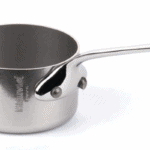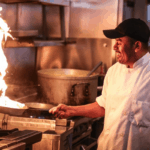There is more focus on the contents of pots and pans, casseroles and trays at the dinner table. There has been an increase in awareness over the last couple decades about how the glaze on your bowl may contain lead, the flaking coating on your frying pan may cause illness, and all kinds of other speculation about carcinogens. You need to know some facts about ceramic cookware health hazards if you’ve been wondering about it. We also have compiled a guide that will help you choose pots and pans for gas stove, if your are looking for the best one.
Ceramics and Cookware
Cookware refers to anything that is used to cook food, which could include ceramic dishes, such as casseroles, trays, baking tins, lidded or not. There is also “ceramic-coated” cookware, such as pots, pans, and frying pans that have become so popular in the last five years.
Ceramic is essentially clay that’s been hardened by fire, and people have been cooking with it for hundreds, if not thousands, of years. Even though ceramic is one of the safest materials to eat off, it can stain or discolor when untreated, which is why it is usually glazed. The glaze often contains cadmium or lead, among other things. Additionally, the clay sourced for ceramics can sometimes be problematic.
How is Cookware “Dangerous”?
Depending on your oven or stove, cookware can reach temperatures of over 700 degrees Fahrenheit when cooking. In certain non-stick cookware, these high temperatures cause chemicals to leach into the food. Among them are cadmium and lead, which are phased out in the United States but are still used elsewhere.
Cookware is often beaten about, heated, stirred, shaken, and scraped. When that occurs, its surface can become scratched or chipped, whether it’s a non-stick finish, enameled cast iron or even a glazed ceramic tajine from Morocco. In the case of metal, this can lead to tiny metal particles getting into your food. You may get glaze or even flakes of ceramic in your food from a chipped ceramic pan, depending on where it comes from and the volume of leaching.
The big fear with suspect cookware is that it will leach toxicity into food, whether the problem is the glaze or ceramics themselves. Some foods, like the tomato or citrus, have an increased acidity that escalates this reaction.
If you look at the numbers, it seems like using these dishes for a meal isn’t particularly dangerous, but a bigger concern is their cumulative effect – i.e., using them meal after meal, day after day. One meal per day at home on these dishes would mean over 365 exposures annually, and those tiny exposures can add up.
It’s Natural, But It’s Dangerous
During the 1980s, a harrowing story came out about a Seattle couple named Don and Fran, two travelers who collected mugs from a family in Italy that made them for seven generations. They used these mugs nearly every day for at least one cup of coffee in the morning.
The couple became nearly fatally poisoned by lead over the next three years and underwent extensive testing to find the source. Those cups were the cause of the poisoning, which nearly killed the couple, which made headlines all over the world. In under an hour, they drank their morning coffee, but an FDA-administered test found after 24 hours that acidic coffee caused over 400 times the accepted levels of lead to leach out of the mugs.
The Origin of Safety Standards
From where does it come? A product that comes from, for example, Japan is likely to be safe because their laws are stringent. Other spots may have less regulation and oversight. In many regions of Europe and Asia, artisans still use lead and other chemicals in their processes.
Why are they allowed to sell dishes made from unsafe materials? The pots are sold as decor items rather than food vessels, so that beautiful pot isn’t meant to be used for cooking. Maybe a merchant didn’t use the proper “not for food” labeling. Perhaps the “not for cooking” label wore off with time. If you buy used ceramics in vintage shops and the like, it’s one of the risks you take.
Don’t use ceramic dishes for hot food if you aren’t sure of their origin or intended use. Use them as a fruit bowl or for party nuts, or for those pinecones you love to display in the autumn. But that’s it.
Using Ceramic Safely
The manufacturer’s care instructions are always recommended, but what if the instructions are not marked? Ceramic cookware should not be used directly on stove elements or flames. To avoid damaging the glazing, use only non-scratch scrubbies or cloths.
When your ceramic shows any cracks or chips, you should stop using it. Beyond the fact that you can consume flakes or chips, bacteria can also live inside the cracks.
Ceramic cannot be recycled, but chipped or cracked ceramic looks great in a garden or holding a pot of succulents on your porch. You can also strategically break ceramics and use the shards to create mosaic patterns on everything from tabletops to mirror frames.
Ceramic-Coated vs. Ceramic Cookware
A new trend in pots and pans is ceramic-coated cookware. The pans are metal coated with ceramic, and they’re nonstick. Coatings are generally considered safe and are made with silicon and other inorganic compounds that don’t contain carbon. Some brands can be oven-safe up to 842 Fahrenheit – nearly 400 degrees higher than Teflon – without emitting fumes or toxins.
It is important to note that ceramic-coated cookware should never be used in extremes back-to-back. In order to avoid cracking a pan’s coating, don’t put it on a hot burner or in a hot oven after taking it out of the refrigerator. Even when ceramic coatings are properly cared for, they are unlikely to last as long as other non-stick coatings. According to some studies, Teflon and similar materials can last six times as long.
Lastly, there are some companies that make skillets and Dutch ovens out of pure ceramics, without any metals. Well-made products are not only safe, but also quality cookware. Xtrema is one such brand that is FDA-approved and backed by a decade-long warranty in addition to receiving high ratings in ceramic cookware reviews. From their award-winning tagines to their French onion soup pots, Emile Henry is a popular French brand. When considering the healthfulness of ceramic cookware versus potential dangers, know that “ceramic cookware” is a big, big category, and that its best-made, highest-quality products tend to be among the safest you’ll find.
Was this helpful?
Hi there! I’m a food enthusiast and journalist, and I have a real passion for food that goes beyond the kitchen. I love my dream job and I’m lucky enough to be able to share my knowledge with readers of several large media outlets. My specialty is writing engaging food-related content, and I take pride in being able to connect with my audience. I’m known for my creativity in the kitchen, and I’m confident that I can be the perfect guide for anyone looking to take their culinary journey to the next level.








